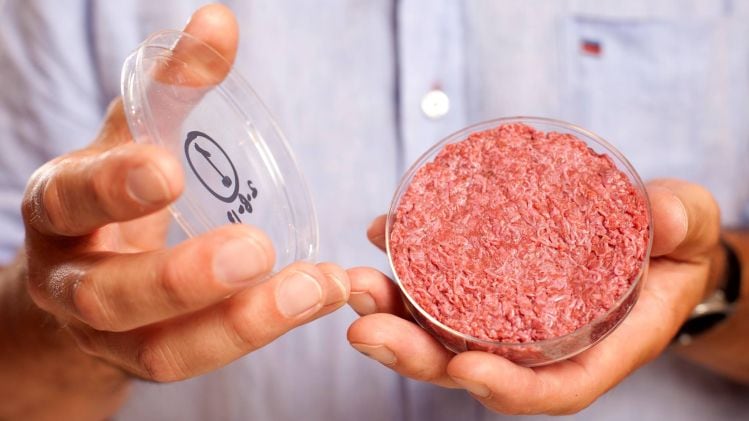The technique - sometimes referred to as 'acellular agriculture' - deploys microbes such as yeast or bacteria as tiny factories to produce proteins, flavors, sweeteners or other products from insulin to rennet.
Instead of culturing cells extracted from chickens, for example, Boulder, CO-based Bond Pet Foods is taking a single celled micro-organism and adding DNA sequences (which can be 3D printed using synthetic biology techniques) which effectively instruct the organism to produce the proteins found in chicken after being fed sugars and other nutrients in a big fermentation tank.
The resulting protein can then be harvested and mixed with other foods to make petfood, said founder and CEO Rich Kelleman, a former ad exec who first started querying the ethics of industrialized meat production after doing some strategy work for a fast food chain, and emerged from the process as a vegetarian (he’s now a vegan).
“It was the first time I really started to think about food sourcing and it was kind of an awakening for me,” said Kelleman. “Flash forward a couple of years and my wife and I got our first puppy together and I started thinking about petfood through the same lens.
“So I started talking to a bunch of people in the emerging clean meat space and I was introduced to the folks at [non-profits] the Good Food Institute and New Harvest and it struck me that if I started with petfood [as opposed to food targeting humans], the bar would not be so high in terms of aesthetics [dogs don’t care what their ‘meat’ looks like as long as it tastes like the real thing]. And I decided to go all in.”
We are taking the DNA that in chicken encodes muscle protein, and putting it into a single-celled microbial host
While Bond Pet Foods originally pursued a cell culture approach deployed by firms such as Memphis Meats, Mosa Meat and Finless Foods to produce its proteins, it has now settled on microbial fermentation for its core protein platform, said Kelleman.
“I am not aware of any other companies producing meat proteins in this way, although there may well be other people out there working on this.
“It’s closest to what Clara Foods [producing egg whites without chickens] and Perfect Day [producing whey and casein without cows] are doing. We are taking the DNA that in chicken encodes muscle protein, and putting it into a single-celled microbial host. We then use the cellular machinery of the microbe to produce chicken-identical protein via fermentation, feeding the cells sugar and simple, non-animal derived nutrients until it reaches a certain density before harvest.
"Down the road we could also grow turkey and cow and pig and so on, but it makes sense to start with chicken as it’s the most consumed protein in the world for people and pets."
The texture of the protein at harvest will be of a baby food consistency
He added: "The chicken muscle proteins are exactly the same with regards to their amino acid sequence as those grown in cell culture. The texture of the protein at harvest will be of a baby food consistency, and gently processed via drum drying for easy mixing into a pet food recipe such as a baked dog treat, for example.
“In the end, the protein itself is always going to be processed in some fashion before it goes into petfood and then cooked with something else to make a complete recipe to give dogs or cats everything they need, whereas in the human food market you need to produce something that can kind of stand up on its own from an aesthetic viewpoint.
“We’re most interested in the nutrition,” added Kelleman, who has teamed up with microbial fermentation expert Pernilla Audibert, PhD to help commercialize the proteins.
There’s a natural resistance from some in the clean meat community to starting with petfood
Supportive though other clean meat start-ups have been, there was some anxiety that if the first product to be commercialized in the space is a protein slurry for Fido - as opposed to a juicy meatball at a high-end restaurant - it could negatively impact consumer perceptions, acknowledged Kelleman, but that's just something the industry will have to deal with.
“There’s a natural resistance [to focusing on petfood] from some in the clean meat community, which I completely understand, but there are other companies out there exploring clean meat and other novel protein sources for petfood such as Wild Earth and Because Animals and a couple of companies in stealth mode in Canada,” he added.

Once we secure funding, we could have our material out there in two to three years
Asked when the first Bond Pet Foods branded products featuring animal proteins might hit the market, he said: “We just opened our seed round last month, so we’re still looking for the resources to accelerate our discoveries, but once we secure funding, it’s feasible we could have our material out there in two to three years.
“We also plan to launch some initial protein products with an amazing amino acid profile from single celled micro-organisms such as fungi and algae around six to nine months after we secure funding to get our brand out there, all while we are working on our core platform of animal proteins.”
Asked about the regulatory framework that might apply to the proteins Bond Pet Foods will be producing, he said: “As with all companies in this space, it’s a journey, but I think what we’re doing may be less of a mystery to regulators than what some others are doing on the cell cultured meat side. We’re working with GRAS [generally recognized as safe] organisms and using processes that are already being used to produce things like food enzymes.”
I’m a brand guy…
So what’s the business model at Bond Pet Foods? To manufacture white label proteins for brands, license its technology, or build a petfood brand making finished products for the retail market?
Definitely the latter, at least in the first instance, said Kelleman. “I’m a brand guy. I’ve worked on brands from Facebook and Chevrolet to Kellogg’s and Procter & Gamble, so our approach is to create our own brand of petfood to get the public to embrace this new way of thinking about foods and proteins. Then, once people have got their heads around that, we can make our proteins available to other companies.”
Marketing messages: There are a lot of levers we can pull
So how might Kelleman harness his inner Don Draper to sell his meat proteins to petfood owners?
“There are a lot of levers we could potentially pull here,” he said. “There are environmental, animal welfare, and food safety benefits; but the great thing is that you can efficiently micro-target groups with the messaging that resonates best with them.
“No matter how we package this, the reality is that some people will think this is Frankenfood, but research shows that younger consumers in particular are open to trying clean meat, and even if only 10% of consumers are interested, for a $30bn market, that’s $3bn, so I think there’s huge potential here.
“If early adopters embrace our food, and see that their pets are happy and healthy, public perceptions will shift. Look at the [plant-based] Impossible Burger. That uses genetic engineering [to produce its star ingredient] but people have really embraced it because it delivers on its promises.”
Meat produced without slaughtering animals offers several advantages over traditional meat, says Good Food Institute senior scientist Dr Liz Specht:
- It does not contain bacterial pathogens that pose food safety risks
- It has a longer shelf life
- It will not suffer from price/supply volatility risks from animal infectious diseases (avian flu, porcine epidemic diarrheal virus)
- It requires fewer inputs for a given quantity of meat
- It is "more controllable and tunable," enabling production of only high-grade meats in quantities dictated by consumer demand, rather than by the biology of the animal.


